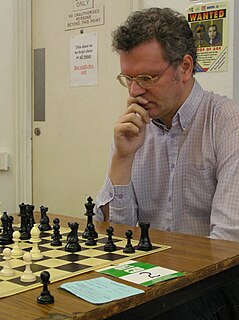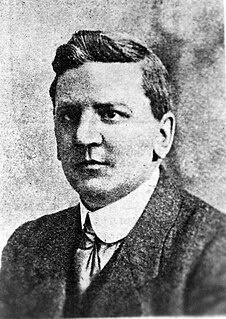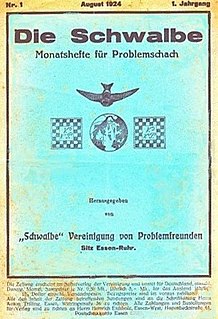
A chess problem, also called a chess composition, is a puzzle set by the composer using chess pieces on a chess board, which presents the solver with a particular task. For instance, a position may be given with the instruction that White is to move first, and checkmate Black in two moves against any possible defence. A chess problem fundamentally differs from over-the-board play in that the latter involves a struggle between black and white, whereas the former involves a competition between the composer and the solver. Most positions which occur in a chess problem are 'unrealistic' in the sense that they are very unlikely to occur in over-the-board play. There is a good deal of specialized jargon used in connection with chess problems; see glossary of chess problems for a list.
A fairy chess piece, variant chess piece, unorthodox chess piece, or heterodox chess piece is a chess piece not used in conventional chess but incorporated into certain chess variants and some chess problems. Compared to conventional pieces, fairy pieces vary mostly in the way they move, but they may also follow special rules for capturing, promotions, etc. Because of the distributed and uncoordinated nature of unorthodox chess development, the same piece can have different names, and different pieces the same name in various contexts. Most are symbolised as inverted or rotated icons of the standard pieces in diagrams, and the meanings of these "wildcards" must be defined in each context separately. Pieces invented for use in chess variants rather than problems sometimes instead have special icons designed for them, but with some exceptions, many of these are not used beyond the individual games for which they were invented.
This page explains commonly used terms in chess problems in alphabetical order. For a list of unorthodox pieces used in chess problems, see Fairy chess piece; for a list of terms used in chess is general, see Glossary of chess; for a list of chess-related games, see List of chess variants.
Fairy chess is the area of chess composition in which there are some changes to the rules of chess. The term was introduced by Henry Tate in 1914. Thomas R. Dawson (1889–1951), the "father of fairy chess", invented many fairy pieces and new conditions. He was also problem editor of Fairy Chess Review (1930–1951).
Andernach chess is a chess variant in which a piece making a capture changes colour. For instance, if a white bishop on a2 were to capture a black knight on g8, the end result would be a black bishop on g8. Non-capturing moves are played as in orthodox chess. If a pawn captures on eighth rank, it is promoted first and then changes colour.
Leonard William Barden is an English chess master, writer, broadcaster, organizer and promoter. The son of a dustman, he was educated at Whitgift School, South Croydon, and Balliol College, Oxford, where he read modern history. He learned to play chess at age 13 while in a school shelter during a World War II German air raid. Within a few years he became one of the country's leading juniors. He represented England in four Chess Olympiads. Barden played a major role in the rise of English chess from the 1970s. He is a chess columnist for various newspapers. His column in London's Evening Standard is the world's longest-running daily chess column by the same author.

Colin Anderson McNab is a Scottish chess player. He is Scotland's second player to be awarded the title of Grandmaster (GM), fulfilling its requirements in 1992 just after Paul Motwani. After achieving his three norms, he strained to get his rating up to the required 2500 level, and is possibly unique among Grandmasters in only achieving a published rating of 2500 some six years after being awarded the title. The FIDE regulations in force at the time stated that an 'intermediate' rating at any stage during an event would suffice, and that ratings between 2498.5 and 2500 would be rounded up, which is indeed what happened in 1992. He is also an International Master of correspondence chess since 1993 and International Master of chess problem solving since 2007.

British Chess Magazine is the world's oldest chess journal in continuous publication. First published in January 1881, it has appeared at monthly intervals ever since. It is frequently known in the chess world as BCM.
This article covers computer software designed to solve, or assist people in creating or solving, chess problems – puzzles in which pieces are laid out as in a game of chess, and may at times be based upon real games of chess that have been played and recorded, but whose aim is to challenge the problemist to find a solution to the posed situation, within the rules of chess, rather than to play games of chess from the beginning against an opponent.

Thomas Rayner Dawson was an English chess problemist and is acknowledged as "the father of Fairy Chess". He invented many fairy pieces and new conditions. He introduced the popular fairy pieces grasshopper, nightrider, and many other fairy chess ideas.

Charles Masson Fox was a Cornish businessman who achieved international prominence in the world of chess problems and a place in the homosexual history of Edwardian England.

Die Schwalbe is the German chess composition society and issues the bimonthly magazine Die Schwalbe.
Fairy Chess Review was a magazine that was devoted principally to fairy chess problems, but also included extensive original results on related questions in mathematical recreations, such as knight's tours and polyominoes, and chess-related word puzzles. It appeared six times per year and nine volumes were published, from 1930 to 1958.
The British Chess Problem Society is considered the oldest chess problem society in the world.

Chess Review is a U.S. chess magazine that was published from January 1933 until October 1969. Until April 1941 it was called The Chess Review. Published in New York, it began on a schedule of at least ten issues a year but later became a monthly. Isaac Kashdan was the editor for the first year, with Al Horowitz and Fred Reinfeld as associate editors. After one year, Kashdan left and Horowitz became editor, a position he retained for the remainder of the magazine's existence. Chess Review was virtually unchallenged as the premier U.S. chess periodical from its start in 1933 until a rival emerged in 1961 after a major revamp of the official United States Chess Federation magazine, Chess Life. The two magazines remained in competition until November 1969, when Horowitz retired and the magazines were merged to become Chess Life & Review.

Nicholas Pert is an English chess grandmaster.
Dynamo chess is a chess variant invented by chess problemists Hans Klüver and Peter Kahl in 1968. The invention was inspired by the closely related variant push chess, invented by Fred Galvin in 1967. The pieces, board, and starting position of Dynamo chess are the same as in orthodox chess, but captures are eliminated and enemy pieces are instead "pushed" or "pulled" off the board. On any given move, a player can make a standard move as in orthodox chess, or execute a "push move" or a "pull move". A move that is either a push move or a pull move is called a "dynamo move".

Andrey Vladimirovich Selivanov is a Soviet and Russian politician and chess problemist. He was Russian State Duma deputy from 1993–2003.

A chess variant is a game related to, derived from, or inspired by chess. Such variants can differ from chess in many different ways.









